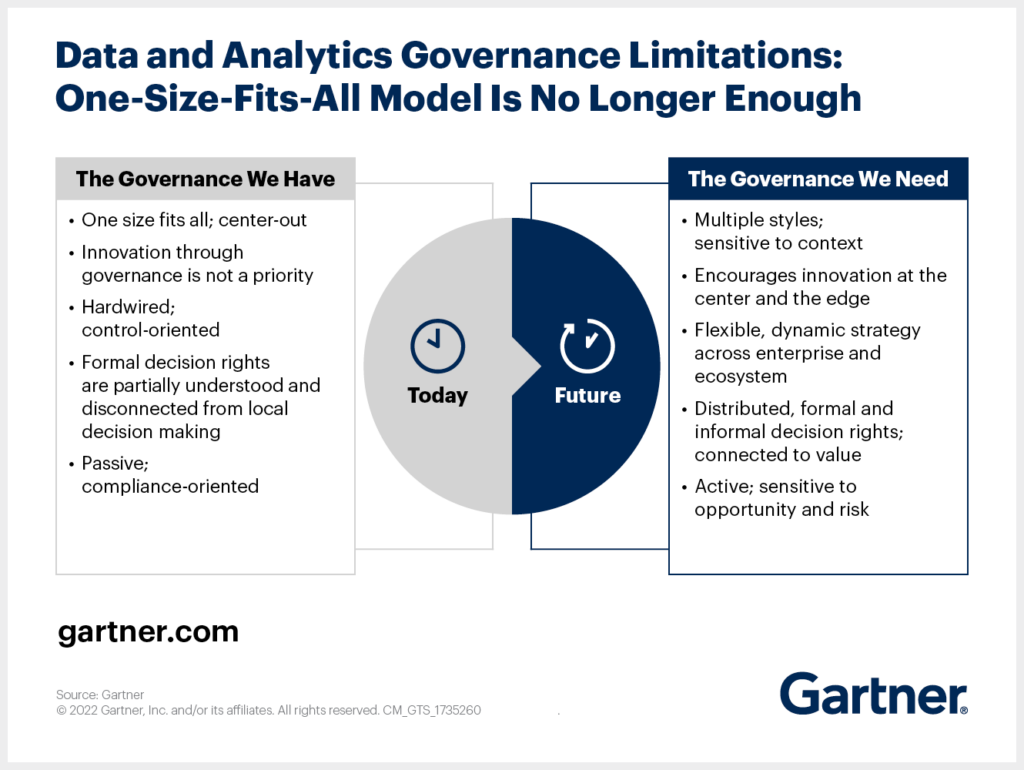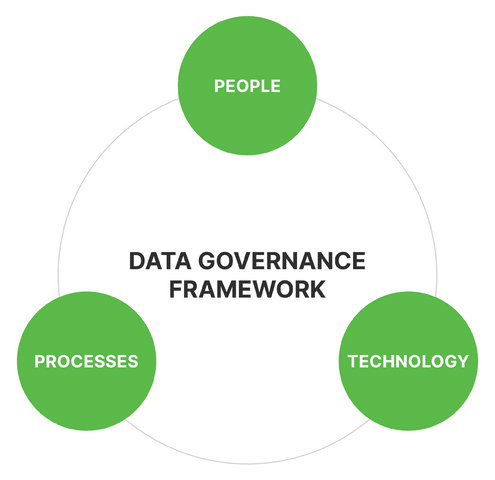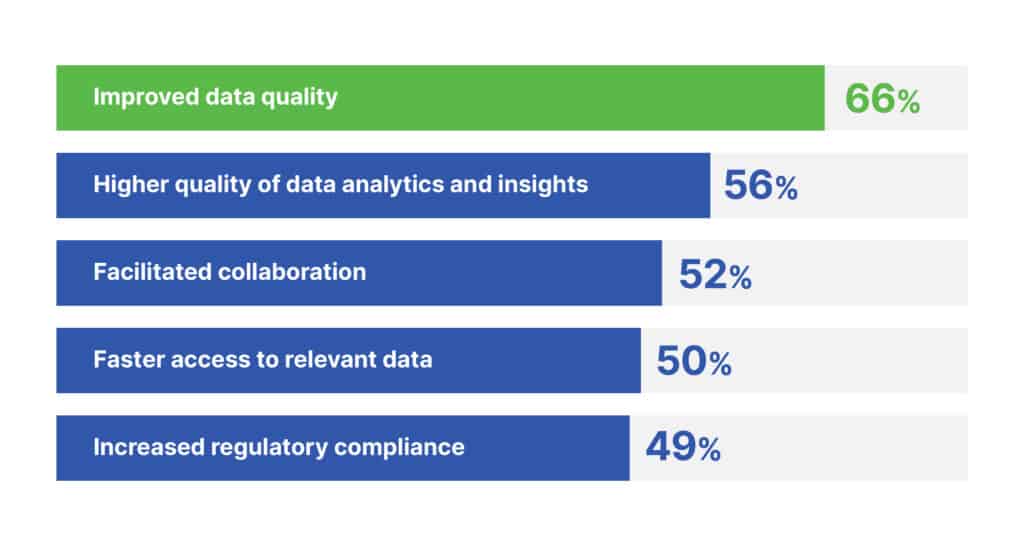
Data & AI Evangelist

Principal Data Architect
Subscribe to the newsletter
In the present digital landscape, data reigns supreme. It is growing in both variety and velocity across different environments, be it on-premises or in the cloud. Recognized as a company’s most valuable asset, the strategic use of data can significantly impact an organization’s success. Ensuring data quality, reliability, and accessibility to the right people at the right time is paramount for informed decision-making. This is precisely where data governance comes into play.
Data governance emerges as the pivotal solution to ensure compliance and security, improve data quality, manage data access, and promote a data-driven culture. Gartner reports that 80% of the organizations that aim to scale their business are likely to fail without a modern approach to data governance. Furthermore, another study suggests that businesses that appoint a designated data governance analyst or data management leader show 42% greater confidence in data quality than those that lack such leadership.
Do you currently have a data governance strategy in place for your organization? This blog sheds light on the significance of data governance, its benefits for businesses, and offers best practices for implementing a robust data governance framework.
What is data governance?
Data governance refers to the overall management of the availability, usability, integrity, and security of data used within an organization. Also, it includes strategies, people, procedures, policies, and standards that ensure effective data management across organizations. Gartner defines data governance as:
“The specification of decision rights and an accountability framework to ensure the appropriate behavior in the valuation, creation, consumption, and control of data and analytics.”
An effective data governance strategy ensures that data is consistent, understandable, trustworthy, and easily accessible for strategic decision-making to improve business outcomes. Without proper governance of data, data integrity and reliability are compromised, posing a significant threat to the organization’s operations and decision-making process. The key goals of data governance include:
- Ensuring, and maintaining the accuracy, consistency, and reliability of data.
- Protecting data from unauthorized access, breaches, or misuse
- Enhancing the value of data
- Appropriate data sharing across the organization
Let’s look at how Gartner explains the current state of data governance and the ideal state that organizations should strive for.

The importance of data governance for business
In the age of data and AI, data governance consulting matters to businesses more than ever. Just as librarians meticulously organize vast collections of books, organizations likewise need structured protocols for effectively managing their business data.
Organizations are more likely to witness data inconsistencies making data management impossible without proper data governance. But the impact goes beyond just that. It also leads to decreased productivity, ineffective decision-making, compliance risk, and legal liabilities for businesses.
Considering these challenges, implementing a robust data governance framework becomes imperative. Such frameworks not only mitigate risks but also help businesses safeguard their reputation in today’s data-centric environment. Key findings from the Survey of Data and Analytics Professionals show that 83% of organizations with mature data governance program see differences in data quality. Owing to this increased data quality, businesses are more likely to gain a competitive advantage.
The trifecta of data governance framework: People, Process, Technology
Since data governance process involves managing, protecting, and utilizing data, it involves 3 key components: people, processes, and technology. It ensures that data is accurately managed to preserve its integrity, protected from unauthorized access, and used appropriately.

People
This component involves roles, responsibilities, and accountabilities within an organization for creating, collecting, using, and managing data. It includes identifying data owners, data stewards, and data custodians, each of whom has their roles for data security, access, and quality.
Process
This component encompasses the procedures, policies, and methods that govern how data is managed throughout its lifecycle. It includes defining data standards, access controls, quality checks, and lifecycle management practices.
Technology
As the name suggests, this component involves leveraging data governance tools and technologies to support data governance activities. This includes automating data management tasks, tracking data lineage, monitoring data quality, and enforcing data access controls. These tools enhance the efficiency of data governance efforts.
This trifecta of people, processes, and technology lays the foundation for successful data governance and management and helps businesses maximize data to achieve their long-term business goals.
Why is data governance important to an organization?
Mckinsey reports that low quality data and productivity causes employees to spend 30% more time on non-value-added tasks.
With vast volumes of data flowing into organizations in various forms, structured and unstructured alike, ensuring that critical information reaches the right individuals at the right time is important for seizing opportunities. Data governance solutions and strategies enable organizations to realize the true value of their data assets and use them intelligently to drive business success.
Through effective data governance best practices, organizations gain tangible data governance benefits, including:

Improved data quality
Data governance ensures data consistency, reliability, and accuracy, which leads to improved data quality. This enhances the trustworthiness of organizational data and enables businesses to make more informed decisions based on reliable data.
Robust data analytics and insights
Trustworthy data is the foundation of robust data analytics. Data governance promotes data quality, allowing organizations to generate accurate and meaningful insights from their data analytics efforts. This empowers organizations to identify trends, optimize operations, and confidently make data-driven predictions.
Systematic collaboration
Data governance promotes collaboration by providing a standardized framework for data sharing and usage across various departments within an organization. This breaks data silos and allows teams to work with the same data, fostering a culture of knowledge sharing for improved productivity.
Faster access to data
By establishing protocols for data management, data governance ensures that authorized users can access the data no matter whenever they need it. Additionally, it minimizes wasted time searching for data, allowing businesses to dedicate their efforts to analysis and actionable insights.
Increased regulatory compliance
Having a solid data governance plan helps organizations comply with regulatory requirements by establishing policies and procedures for data handling and privacy protection. Moreover, data governance and compliance reduces the risk of non-compliance risks and reputational damage, safeguarding the organization’s integrity and trustworthiness.
Considering these benefits of data governance, it makes sense why the data governance market is continuously flourishing. As of 2024, the market size is valued at USD 3.27 billion and is expected to reach USD 8.03 billion by 2029.
Five best practices for data governance you should implement
Ready to implement and benefit from a data governance strategy? It is important to note that every organization is inherently unique, so a one-size-fits-all approach does not work well with data governance. Each organization has its individual framework tailored to its specific needs. However, if your organization is planning for the implementation of data governance, get started with these data governance best practices:
1. Define data governance objectives and goals
The foundation of any successful data governance plan lies in clearly defined objectives and goals. These should be aligned with your organization’s overall business strategy and address specific data-related challenges.
Make sure to clearly understand the long-term goals you want to achieve. Do you want to increase accountability? Improve data quality? Enhance decision-making? Clearly defining your goals will provide a roadmap for an effective data governance implementation.
2. Get the support of executives
Once the goals and objectives have been outlined, gain support from senior leadership for the data governance initiative. This includes executive sponsors, managers, data architects, IT staff, and data custodians within and outside the organization. Gaining executive support will help organizations overcome barriers and ensure the success of data governance frameworks. Moreover, engaging stakeholders and implementing a data framework program will become a strategic advantage for your organization.
3. Access your organization’s readiness
Conduct a thorough assessment of your organization’s readiness to implement a data governance framework. Evaluate multiple factors such as organizational culture, data maturity, existing data management practices, and technological capabilities. Identify potential challenges and opportunities for the proper implementation of the data governance framework.
Running an assessment will help you identify the strengths and loopholes in your organization’s data governance maturity level and pinpoint areas for improvement or refinement.
4. Define data governance roles and responsibilities
Clearly define the roles and responsibilities of the resources involved in data governance, such as data stewards, data owners, data custodians, data users, and data governance council for collecting, storing, and using data. By outlining the data governance roles, each team member will understand their role and contribute effectively to data governance efforts. However, the key to success is to create a company culture that promotes data-driven practices.
5. Implement data quality management
Another important practice for the data governance framework is implementing data quality management. Establish processes and mechanisms for monitoring and improving data quality throughout the organization. This includes conducting data profiling, cleansing, and validation activities to ensure data accuracy, completeness, and consistency.
Implement tools and technologies to automate data quality processes and enable continuous monitoring and improvement. However, by prioritizing data quality governance and management, businesses are more likely to enhance the trustworthiness and integrity of their data assets.
Start your data governance journey with Confiz
Irrespective of your organization’s size, data governance ensures that data is used, protected, and managed appropriately, thereby safeguarding its accuracy and integrity. Without effective data governance, businesses face data inconsistencies, security breaches, and impaired decision-making processes. Data governance is a strategic investment to propel your business ahead of the competition.
Want to make data governance effortless? Not sure where you stand in your data governance journey? Drop us a line at marketing@confiz.com to explore how our data architects and strategists can collaborate with you to improve and advance your data governance initiatives.



